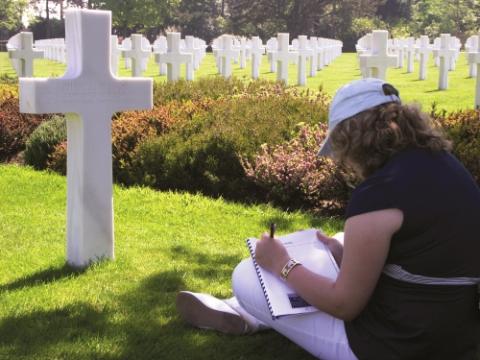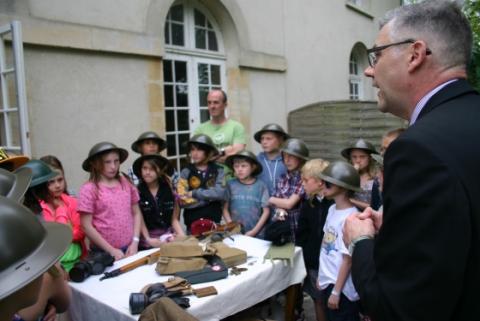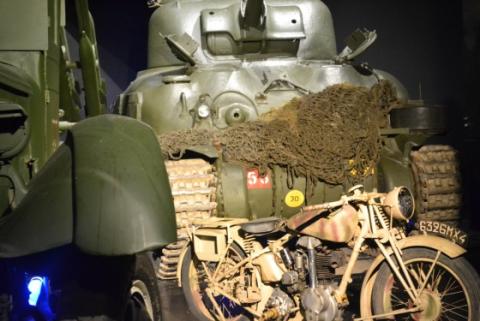Covering primary level to GCSE stage, Normandy provides the perfect setting for encouraging school students to ask more questions about history including WWI and WWII. Help them learn how to uncover history in context.
35 minutes – The time it takes for school groups to travel from Folkestone to Calais and access the gateway to Continental Europe.
We can assume it took a little longer for William the Conqueror and his soldiers to cross the twenty-plus miles of the Channel, but Normandy remains an ever popular region for schools looking to take learning outside the classroom to support their students’ progress through the curriculum.

Normandy is packed with educational opportunities to help encourage students to become more active and vocal (in positive ways!) in their classrooms. We explore how Normandy can prompt the right questions and lines of inquiry back at home.
Knowledge and understanding through historical inquiry
The Norman Conquest continues to be a part of the curriculum’s breadth of study across the Key Stages. A history trip to this region allows students to further understand the impact of the Norman invasion on British society. There are key artefacts, found only in Normandy, to help their comprehension of the topic.
The Bayeux Tapestry is an excellent example of a source to support this historical inquiry. The tapestry depicts the events leading up to the Norman conquest of England and the consequential Battle of Hastings. The 230ft long embroidered cloth is amazing for students to physically see a real life source material to use to trace the history of the period.
The history of the artefact itself is a sight to behold with incredible detail and colour that has lasted over 9 centuries. Your young historians will get a unique first-hand experience to see a piece of history right in front of them. Through discussion they’ll evaluate what can be gained from the source and place their learning in context.
A visit here also ties in neatly with a trip to the birthplace of William the Conqueror at Falaise Castle to better understand his significance and development of the monarchy.
“I thought it was really fun. The Chateau was great and I love the history in Normandy”
Understanding D-Day
A battlefields tour gives children the chance to deepen their study of the D-Day landings. The memorial at Omaha Beach has invasion maps and narratives explaining the assault upon the German front line. Seeing the beach before their eyes will help your class understand how Operation Overlord was executed. Students can launch their own investigation to ascertain the importance of taking control of this section to link up with the landings at both Gold and Utah along the coast.

Last year saw the Steeple Claydon School engage with D-Day veterans to mark the 70th anniversary of Normandy Landings. Students were given eyewitness accounts of life during the period, details on the conditions soldiers were faced with and had the chance to handle real artefacts from the period!
“A fantastic trip enjoyed by children and adults! The WW2 veterans talk was great. The children have learnt so much history is a short space of time”
Excursions = questioning
Studying this significant period supports young learners in their understanding of the impact of the World War Two on the wider world. Key visits include:
- Arromanches remains an outstanding example of the technical feat achieved during World War Two with 600,000 tonnes of concrete and equipment transported across the Channel.
- The remains of the Mulberry harbour act as a reminder of the scars of war at the heart of the landings.
- The D-Day tour continues into the Museum where artefacts, models and media bring together a bigger picture of the events along the northern coastline.
- The 360 degree cinema at Arromanches is a must-see detailing the Battle of Normandy and the impact not only the infantry men who stormed the beaches for the liberation of Europe but the civilians who also sacrificed so much to pave the way for hope.
Maximising learning outside the classroom
For schools groups studying this period in Modern history, Normandy becomes an outdoor museum. It provides endless opportunities to delve deeper into the cause and effects of World War Two. Tours of battlefield show students something ‘real’; they are able to see into the nature of war and begin to comprehend its severe impact.
From archive footage of soldiers leaping ‘into the jaws of death’, to the poignant reminder of the many lives lost at the American cemetery at Omaha Beach, a history trip here helps students gain a new perspective of World War Two. They’ll develop their ability to use inquiry and interpret information.

There remains more to taking your students to Normandy than just the obvious educational benefits. Experiences are key to students’ development. It is these moments – as they marvel at the defences at Point du Hoc or analyse the strategic positioning of Pegasus Bridge – that they will share with their peers.
This new environment means claiming a degree of independence while also developing their ability to communicate. The chance for student enrichment while gaining knowledge of history, means teachers are able to cover curriculum goals while providing a trip that will fuel discussion in the classroom.


Comments are closed here.